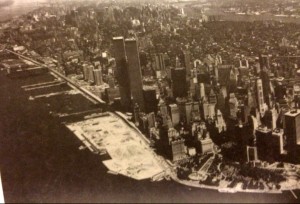By Shuo Cheng
In this post, I will explore paradigm of public vs private development through the context of the history of Battery Park City.
Before the 1960’s, the location which is now known today as Battery Park City was once a confluence of rotting piers and ports, piers that haven’t seen busy activity since before World War II. Since World War II, modern technology improved how the shipping industry operated and the piers lining the location that is now Battery Park City were made obsolete. During the 60’s, the city saw the opportunities provided by the space occupied by the rotting, unused piers and decided to fill in the space, creating new land and opportunities to redevelop both New York City’s waterfront and reputation.
Four powerful organizations vied for the opportunity to lead the redevelopment of those piers. These four included the Department of Marine and Aviation (DMA), the Downtown – Lower Manhattan Association (DLMA), the New York City Planning Association (DLMA) and the state of New York with primary interest from the then Governor Nelson Rockefeller.
DMA: The DMA provided a mixed-use plan that divided up the future waterfront into commercial and residential uses. The plan intricately specified six commercial pier slips, eight office buildings, eighteen high-rise apartment buildings with forty-five hundred units and a forty story hotel.
DLMA: The DLMA presented their plan after the DMA. Their plan included only commercial office buildings and residential high-rises along with one hotel.
Governor Nelson Rockefeller: Governor Rockefeller’s interest into the project probably arose from his earlier work with the World Trade Center project along with the United Nations headquarters. Working with Wallace Harrison, Rockefeller’s plan involved turning the filled land into an assortment of uses. The plan proposed light industry in combination with mix income housing and wide expansive green spaces reminisce of Le Corbusian style.
The four different groups mentioned represent various interest groups. Both the Department of Marine and Aviation and the Planning Association were organizations that worked for the city government which meant that they should represent the needs of the city. The other two interest groups, namely Nelson Rockefeller and the Downtown – Lower Manhattan Association were both private groups interested in reshaping lower Manhattan. By the time the landfill process was complete, the City Planning Association retained control over the land but was unable to do anything due to lack of financial resources.
Each group’s proposals had each’s own strengths and weaknesses. However by 1970’s, resources were insufficient to act on any of these proposals. The project stalled until 1979 when a new plan was adopted. This new plan ditched the futurist views that older proposals suggested in favor of hard calculated realistic goals. During that time, power over the project was transferred from the Planning Association to the newly formed Battery Park City Authority.
After the economy rebounded from the financial crisis in the 70’s, Battery Park City Authority started out selling bonds in order to finance the redevelopment process allowing private entities to gain influence over parts of the project.
The Battery Park City project is one of the best examples of public private development where public agencies reach out to private investors and developers to actually complete the project. Throughout the 40 year realization of this project, multiple powers struggles defining and redefining the 20 block long piece of land into what it is now today. These struggles were important to the carefully planned out result. As a counterexample to the drab uniform landscapes that marked the Federal Renewal era of the 50’s, Battery Park City marks the collaborative efforts of multiple organizations and their disputes and coming together to form one of the most iconic waterfronts in the world.
Part II: Battery Park City II: Public Private Land-Use
Sources
Sagalyn, Lynne B., Journal of American Planning Association (Winter 2007) Public/Private Development: Lessons from History, Research, and Practice
Brown, Peter H. (2009) America’s Waterfront Revival: Port Authorities and Urban Redevelopment. University of Pennsylvania Press.
Gordon D. L. A. (1997) . Battery Park City: Politics and Planning on the New York Waterfront. Routledge Press
Wrenn D. M., Casazza, J.A., & Smart J. E. (1983). Urban Waterfront Development. Washington, D.C.: Urban Land Institue.

